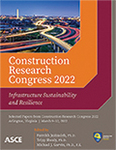Unifying Assessments of Sustainability and Resilience in Civil Infrastructure Systems: The Case of Masonry Structures
Publication: Construction Research Congress 2022
ABSTRACT
Both sustainability and resilience considerations are important for infrastructure systems; however, there is a lack of single effective framework to unify sustainability and resilience, especially in context of building systems. The empirical literature also suggests very limited efforts that unify both aspects in a holistic manner, a challenge to accomplish in practice. This requires identification of critical indicators associated with sustainability and resilience. Careful assessments are required while exploring the different phases of infrastructure life cycle because they can reinforce or undermine each other. Along these lines of research, this study contributes a novel experimental framework to assess masonry structures and support the unified approach. Specifically, this study performed structural analysis for resilience assessment in masonry structures and energy simulation for sustainability. Based on the openings available in masonry walls, the study observed the changes in sustainability indicators, such as electricity consumption, due to space and water heating, and area lighting among others. Moreover, changes in resilience indicators such as story drifts in each floor were also observed. Results from sustainability assessment indicate that overall sustainability is compromised with additional openings in most cases (i.e., the building becomes less sustainable because of higher electricity energy consumption), except for electricity consumption for space heating. Results from resilience assessment show an increase in story drift of different floors with additional openings. It indicates that with additional openings, an unreinforced masonry building becomes more vulnerable. Moreover, differential effects (positive/negative correlations) were observed when concurrent assessments were made on sustainability and resilience indicators.
Get full access to this article
View all available purchase options and get full access to this chapter.
REFERENCES
Bocchini, P., D. M. Frangopol, T. Ummenhofer, and T. Zinke. (2013). “Resilience and sustainability of civil infrastructure: Toward a unified approach.” Journal of Infrastructure Systems 20(2): 04014004.
Bosher, L., P. Carrillo, A. Dainty, J. Glass, and A. Price. (2007). “Realising a resilient and sustainable built environment: towards a strategic agenda for the United Kingdom.” Disasters 31(3): 236–255.
Bozza, A., D. Asprone, and G. Manfredi. (2015). “Developing an integrated framework to quantify resilience of urban systems against disasters.” Natural Hazards 78(3): 1729–1748.
Brundtland, G. H. (1987). Our common future: Brundtland-report. Oxford University Press, Oxford.
Champagne, C. L., and C. B. Aktas. (2016). “Assessing the resilience of LEED certified green buildings.” Procedia Engineering 145: 380–387.
Cutter, S. L., L. Barnes, M. Berry, C. Burton, E. Evans, E. Tate, and J. Webb. (2008). “A place-based model for understanding community resilience to natural disasters.” Global environmental change 18(4): 598–606.
Griggs, D., M. Stafford-Smith, O. Gaffney, J. Rockström, M. C. Öhman, P. Shyamsundar, W. Steffen, G. Glaser, N. Kanie, and I. Noble. (2013). “Policy: Sustainable development goals for people and planet.” Nature 495(7441): 305.
Hasik, V., J. Chhabra, G. P. Warn, and M. Bilec. (2017). Investigation of the sustainability and resilience characteristics of buildings including existing and potential assessment metrics. AEI 2017: 1019–1033.
Lew, A. A., P. T. Ng, C.-C. Ni, and T.-C. Wu. (2016). “Community sustainability and resilience: Similarities, differences and indicators.” Tourism Geographies 18(1): 18–27.
Lizarralde, G., K. Chmutina, L. Bosher, and A. Dainty. (2015). “Sustainability and resilience in the built environment: The challenges of establishing a turquoise agenda in the UK.” Sustainable Cities and Society 15: 96–104.
Marjaba, G., and S. Chidiac. (2016). “Sustainability and resiliency metrics for buildings–Critical review.” Building and environment 101: 116–125.
Redman, C. (2014). “Should sustainability and resilience be combined or remain distinct pursuits?” Ecology and Society 19(2).
Roostaie, S., N. Nawari, and C. Kibert. (2019). “Sustainability and resilience: A review of definitions, relationships, and their integration into a combined building assessment framework.” Building and Environment.
Zolli, A., and A. M. Healy. (2012). Resilience: Why things bounce back, Hachette UK.
Information & Authors
Information
Published In
History
Published online: Mar 7, 2022
Authors
Metrics & Citations
Metrics
Citations
Download citation
If you have the appropriate software installed, you can download article citation data to the citation manager of your choice. Simply select your manager software from the list below and click Download.
